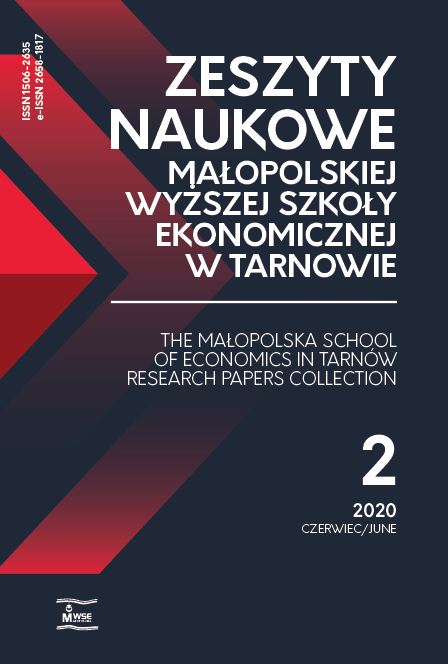Abstract
Contemporary tourism is a phenomenon on a global scale. The numer of participants in global tourism is constantly increasing. Only in 2018, 1.4 billion trips were made. Like all phenomena in the world, tourism is also constantly changing. Variation may concern travel directions, but also the reasons for it. Visiting areas of social exclusion and poverty are among the most original motives for travelling. The purpose of the publication is to show that slums around the world can be an important place for tourist reception, while being places with a specific quality. Research methods used in the work are literary criticism and analysis of existing data. The publication was written using compact data, scientific articles and netographic data. The results of the scientific analysis clearly show that slums as tourist destinations bring with them a varied tourist valorization, including the opportunity to get to know local entrepreneurship, organization of everyday life, difficult life or survival in specific living conditions.
References
Basista, H. (2001). Betonowe dziedzictwo. Architektura w Polsce czasów komunizmu. Warszawa: Wydawnictwo Naukowe PWN. ISBN 8301132248.
View in Google Scholar
Bogacz i nędzarz. (2016). Online forum [online, accessed: 2019-12-05]. Retrieved from: http://forum.zbawieniedlaciebie.pl/viewtopic.php?t=446.
View in Google Scholar
Borowik, I. (2003). Blokowiska. Miejski habitat w oglądzie socjologicznym. Studium jakości wrocławskich środowisk mieszkaniowych. Wrocław: Uniwersytet Wrocławski. Wydział Nauk Społecznych – Oficyna Wydawnicza „Arboretum”. ISBN 8386308826.
View in Google Scholar
Buczkowska, K. (2014). Turysta w slumsach, czyli o (nie)wyraźnej granicy pomiędzy turystyką etyczną i nieetyczną. In: M. Kazimierczak (ed.). Etyczny wymiar podróży kulturowych. Poznań: Akademia Wychowania Fizycznego im. Eugeniusza Piaseckiego. ISBN 9788361414957.
View in Google Scholar
Calado, B. (2016). Rocinha: de fazenda a maior favela do Rio de Janeiro [online, accessed 2019-12-04]. MultiRio: a midia educative da cidade. Da Serie Bairros Cariocas. Retrieved from: http://www.multirio.rj.gov.br/index.php/leia/reportagens-artigos/reportagens/8689-rocinha-de-fazenda-a-maior-favela-do-rio-de-janeiro.
View in Google Scholar
Chwalba, A. (2012). Historia powszechna. Wiek XIX. Warszawa: Wydawnictwo Naukowe PWN. ISBN 9788301160050.
View in Google Scholar
Davis, M. (2009). Planeta slumsów. Transl. by K. Bielińska. Warszawa: Instytut Wydawniczy Książka i Prasa. ISBN 9788388353970.
View in Google Scholar
Dijk, J. van (2010). Społeczne aspekty nowych mediów. Analiza społeczeństwa sieci. Transl. by J. Konieczny. Warszawa: Wydawnictwo Naukowe PWN. ISBN 9788301162900.
View in Google Scholar
Eckstein, S. (1990). Urbanization revisited: Inner-city slum of hope and squatter settlement of despair. World Development, 18(2), 165–181. DOI: 10.1016/0305-750X(90)90046-Z.
View in Google Scholar
Edmonds, E. V., Pavcnik, N. (2005). Child labor in the global economy. Journal of Economic Perspectives, 19(1), 199–220.
View in Google Scholar
Frenzel, F., Steinbrink, M., Koens, K. (2012). Slum tourism: Development and globalization of a new trend in tourism. In: F. Frenzel. M. Steinbrink, K. Koens. Slum Tourism: Poverty, Power and Ethics. New York: Routledge. ISBN 9780415698788.
View in Google Scholar
Gandecka, A. (2016). Ostatnia enklawa autentyczności? Slumsy jako atrakcja turystyczna [online, accessed: 2019-12-15]. Turystyka Kulturowa, 6, 90–107. Retrieved from: http://cejsh.icm.edu.pl/cejsh/element/bwmeta1.element.desklight-a1ba0c54-6ce5-47c6-92c1-c5bc2d8f037b/c/gandecka.pdf.
View in Google Scholar
Gawlik, G. (2013). Kair – miasto umarłych, miasto żywych [online, accessed: 2019-12-08]. Onet Podróże. Retrieved from: https://podroze.onet.pl/ciekawe/kair-miasto-umarlych-miasto-zywych/jw23v0w.
View in Google Scholar
Geerts, W., Popova, N., Bremner, C., Nelson, P. (2017). Top 100 City Destinations Ranking: WTM London 2017 Edition [online, accessed: 2019-12-15]. London: Euromonitor International. Retrieved from: http://go.euromonitor.com/Top_100_City_Destinations_WTM_Form_Download.html?utm_campaign=FR-160128-Top%20100%20Cities&utm_medium=Blog&utm_source=Blog#download-link.
View in Google Scholar
Hayes, R. (2016). Favela Community NGOs Fill the Gaps in Rio’s Educational System [online, accessed: 2017-11-04]. RioOnWatch: Community Reporting on Rio. Retrieved from: https://www.rioonwatch.org/?p=32232.
View in Google Scholar
Hernández García, J. (2013). Slum tourism, city branding and social urbanism: The case of Medellin, Colombia. Journal of Place Management and Development, 6(1), 43–51. DOI: 10.1108/17538331311306122.
View in Google Scholar
Krzyk, P. (2013). Slumsy Haiti [online, accessed: 2019-12-04]. Wędrówki z Pawłem… Blog podróżniczy. Retrieved from: http://wedrowkizpawlem.pl/ameryka-polnocna/haiti/slumsy-haiti/.
View in Google Scholar
Lee, J. (2009). When ‘slumming’ was the thing to do [online, accessed: 2019-12-15]. The New York Times. Retrieved from: https://cityroom.blogs.nytimes.com/2009/07/06/when-slumming-was-the-thing-to-do/.
View in Google Scholar
Olczyk, M. (2013). Moralne aspekty turystyki. Teologia i Moralność, 8(1), 211–231.
View in Google Scholar
Ostaszewski, M. (2014). Kamagasaki – japońska dzielnica biedy w Osace [online, accessed: 2019-12-08]. Bankier.pl. Warszawa: Bonnier Business Polska. Retrieved from: https://www.bankier.pl/wiadomosc/Kamagasaki-japonska-dzielnica-biedy-w-Osace-3216504.html.
View in Google Scholar
Perry, A. (2010). Nairobi: 10 things to do [online, accessed: 2019-12-05]. Time. Retrieved from: http://content.time.com/time/travel/cityguide/article/0,31489,1974866_1974860_1974810,00.html.
View in Google Scholar
Rana, M. (2017). What is a slum? What is slum housing area: Definitions [online, accessed: 2019-12-05]. Retrieved from: http://architectboy.com/what-is-a-slum.
View in Google Scholar
Rankingi24.pl. (2014). 10 największych slumsów świata [online, accessed: 2019-12-08]. Retrieved from: http://rankingi24.pl/rozne/442-10-najwiekszych-slumsow-swiata.html.
View in Google Scholar
Sadowski, P. (2019). „Slumming” – wycieczki bogatych po dzielnicach biedy wciąż modne [online, accessed: 2019-12-15]. National Geografic Polska. Retrieved from: https://www.national-geographic.pl/aktualnosci/turystyka-ubostwa-przejaw-swiadomosci-podroznikow-czy-sposob-na-budowaniepoczucia-wyzszosci.
View in Google Scholar
Sikora, J. (2015). Etyczne aspekty turystyki kontrowersyjnej w warunkach komercjalizacji rynku turystycznego. In: G. Godlewski, M. Zalech (eds.). Turystyka kontrowersyjna na współczesnym rynku podróży – formy, uwarunkowania, skutki. Biała Podlaska: Akademia Wychowania Fizycznego Józefa Piłsudskiego w Warszawie, Wydział Turystyki i Zdrowia. ISBN 9788361509301.
View in Google Scholar
Steinbrink, M., Pott, A. (2010). Global Slumming. Zur Genese und Globalisierung des Armutstourismus In: H. Wöhler, A. Pott, V. Denzer. Tourismusräume. Zur soziokulturellen Konstruktion eines globalen Phänomens. Bielefeld: Transcript-Verlag. ISBN 9783837611946.
View in Google Scholar
Totaro, P. (2016). Dying for a pee: Cape Town’s slum residents battle for sanitation [online, accessed: 2019-12-08]. Reuters: World News. Retrieved from: https://www.reuters.com/article/us-safrica-slums-sanitation/dying-for-a-pee-cape-towns-slum-residents-battle-for-sanitation-idUSKCN12C1WA.
View in Google Scholar
TTG Polska. (2018). Hotel w slumsach za 100 zł [online, accessed: 2019-12-08]. TTG Dziennik Turystyczny – internetowy serwis branży turystycznej. Warszawa: TTG Polska. Retrieved from: http://ttg.com.pl/hotel-w-slumsach-za-100-zl/.
View in Google Scholar
UN-Habitat. (2012). State of the World’s Cities 2012/2013: Prosperity of Cities. Nairobi: United Nations Human Settlements Programme (UN-Habitat). Retrieved from: https://sustainabledevelopment.un.org/content/documents/745habitat.pdf.
View in Google Scholar
WP Turystyka. (2012). Największe slumsy świata: Petare w Caracas, Wenezuela [online, accessed: 2017-11-20]. Wirtualna Polska: Turystyka. Retrieved from: https://turystyka.wp.pl/najwieksze-slumsy-swiata-6043969836450945g/3.
View in Google Scholar
WP Turystyka. (2014a). Brazylia – slumsy w Rio hitem mundialu? [online, accessed: 2017-11-20]. Wirtualna Polska: Turystyka. Retrieved from: https://turystyka.wp.pl/brazylia-slumsy-w-rio-hitem-mundialu-6044413002171521a.
View in Google Scholar
WP Turystyka. (2014b). Slumsy – podróż do świata koszmaru [online, accessed: 2017-11-20]. Wirtualna Polska: Turystyka. Retrieved from: https://turystyka.wp.pl/slumsy-podroz-do-swiata-koszmaru-6043991502398593g?src01=f1e45.
View in Google Scholar

This work is licensed under a Creative Commons Attribution-NonCommercial-NoDerivatives 4.0 International License.

